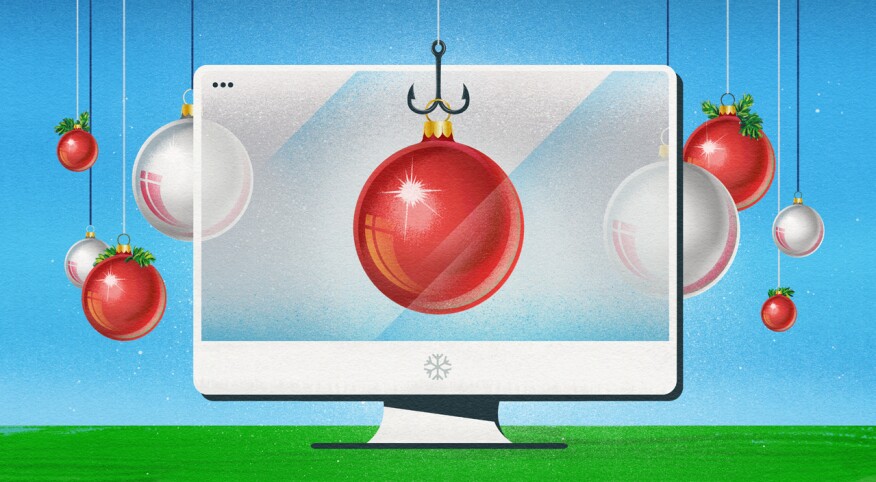Find out more about the AARP Fraud Watch Network — a free resource for all.
Just as retailers ramp up for the holiday shopping season, so do the cyber scammers. These ruthless fraudsters will be hard at work to fill our email inboxes with fake shipping notices, confirmations for purchases you didn’t make, offers too good to be true, and emails that look like they are from an old friend. As the founder of Tech Moxie, a technology coaching and education company, we see all of these — and more. Many of my older clients believe that they have fallen victim to a tech scam because of their age or general lack of tech knowledge. After reviewing literally hundreds of scams, I have no doubt we are all vulnerable regardless of our age, intelligence or tech ability. Yes, even millennials get scammed! Fraudsters have become quite adept at getting us to let our guard down. However, by learning their tricks we can all learn to recognize a scam before it is too late.
Scams have become much more sophisticated since the days of the “Royal Prince” emails from a “foreign dignitary” in desperate need of help transferring his fortune out the country. Online fraud is now big business, and the scammers are carefully designing their schemes to tap into our psychological vulnerabilities. This technique has a name — social engineering — defined by Wikipedia “as the psychological manipulation of people into performing actions or divulging confidential information.” With social engineering, fraudsters take advantage of our anxieties, naivete and general tendency to take things at face value. This leads us to click and divulge private information when we shouldn’t.
Tapping into our anxieties
If an email has our bank's name and logo, we may readily assume that it is actually from our bank. But the scammers also want to create a sense of urgency and take it a step further. The email might claim that your bank account has been compromised and instruct you to click on a link to regain access. This taps into our anxiety about identity theft and online fraud. This causes us to hyper focus on the perceived risk — possible bank fraud — and ignore the possibility that the email itself is fraudulent. If clicked, the fraudulent link takes you to a fake bank login page that asks for your username and password. And just like that the fraudster has captured your sensitive and valuable information.
Often these scams start on the telephone. I was recently called in to help a woman who received a call that she thought was from Microsoft. Very cleverly, the fraudster created a caller ID that displayed the words “Microsoft Support” along with a phone number. The fraudster told my client that someone had downloaded illegal porn on her computer, but not to worry — “Microsoft” would help her remove it. All she had to do was give the caller password access to her computer.
This preyed on the person’s anxiety about having illegal material on her computer, and additionally into her naivete about computing and customer service. She did not know that Microsoft (nor any tech company) does not make unsolicited calls to customers. And thankfully, the real Microsoft would have no way of knowing what we have on our computers. Sadly, she gave the scammers access to the computer, which had a treasure trove of personal information.
So, how do we stay safe?
Protecting ourselves is easier than it might seem given that it is nearly impossible to stay abreast of all the variations of these scams. I advise my clients to think about online safety as they do their personal safety. Women instinctively know to never walk down the street with an open purse. Nor would we leave a wallet in a shopping cart while we step over to the next aisle. By taking these precautions we are implicitly assuming that anyone walking near us could be a thief.
But rather than making us more fearful, these steps should increase our sense of safety. Applying this to the tech world, we must assume that each and every phone call, email and text could be fraudulent. Always remember that emails can be made to look like they came from your bank, from Amazon, or even from a friend.
My simple rule: Think before you click
Take steps to independently verify the sender or caller. If an email appears to be from Amazon confirming a purchase you didn’t make, instead of clicking on the link (which would then ask for your Amazon password), go directly to your Amazon account via your web browser (for example, Chrome, Safari or Edge). If a fraudulent purchase was made you will see it in your order history. If an email looks like it is from a friend asking for a favor, give that friend a call to verify. Phone calls can be a little trickier. If the caller says they are from your bank, hang up and call the bank directly using the telephone number on your statement or the back of your credit card. If the caller claims to be from the IRS, law enforcement, or perhaps the Social Security Administration, just know that government organizations never call to demand payment (or anything else for that matter).
Nearly all scams that I have heard of in my years running Tech Moxie succeed because people mistakenly take that one step, click or action that gives the scammers what they want. The good news is that it is within our control to decide not to take the bait. Stay safe this holiday season, and think before you click!

Valero Doval


